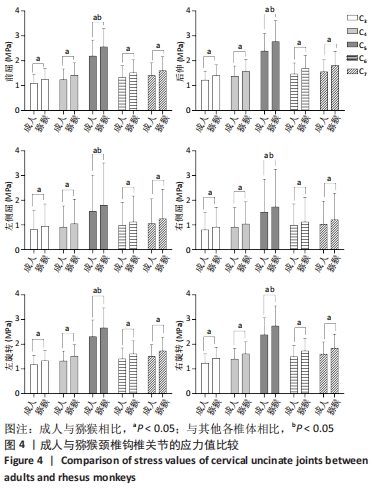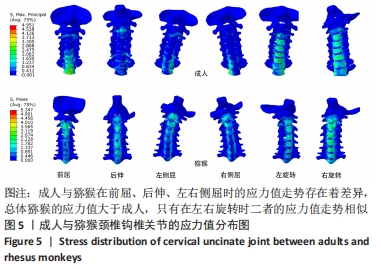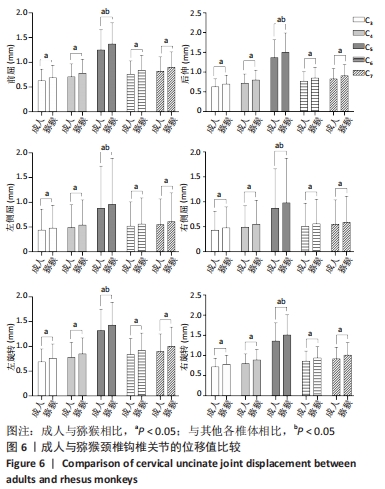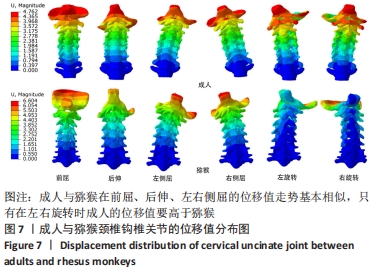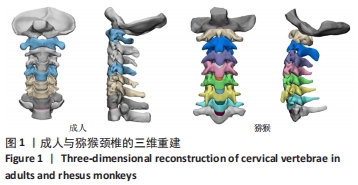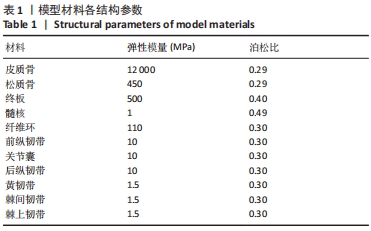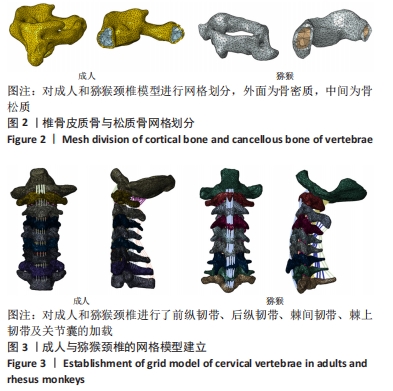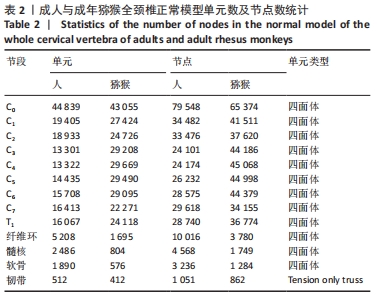中国组织工程研究 ›› 2023, Vol. 27 ›› Issue (13): 2022-2027.doi: 10.12307/2023.255
• 数字化骨科 digital orthopedics • 上一篇 下一篇
人与成年猕猴全颈椎有限元模型建立及有效性验证的对比
王 星1,2,李 琨1,2,马 渊2,张少杰1,2,王超群3,高明杰1,郑秉武4,陈 杰1,李筱贺1,张志峰5,郑雷刚6,史 君7,李志军1,2
- 内蒙古医科大学基础医学院,1解剖学教研室,7生理学教研室,内蒙古自治区呼和浩特市 010110;2内蒙古医科大学数字医学中心,内蒙古自治区呼和浩特市 010059;3内蒙古医科大学附属医院影像科,内蒙古自治区呼和浩特市 010050;4呼和浩特市动物园管理处,内蒙古自治区呼和浩特市 010070;5内蒙古医科大学第二附属医院关节科,内蒙古自治区呼和浩特市 010000;6内蒙古自治区中医医院中医骨伤科,内蒙古自治区呼和浩特市 010020
Comparison of finite element model establishment and validity verification of total cervical vertebrae between human and adult rhesus monkeys
Wang Xing1, 2, Li Kun1, 2, Ma Yuan2, Zhang Shaojie1, 2, Wang Chaoqun3, Gao Mingjie1, Zheng Bingwu4, Chen Jie1, Li Xiaohe1, Zhang Zhifeng5, Zheng Leigang6, Shi Jun7, Li Zhijun1, 2
- 1Department of Anatomy, 7Department of Physiology, School of Basic Medicine, Inner Mongolia Medical University; 2Digital Medical Center of Inner Mongolia Medical University; 3Department of Imaging, Affiliated Hospital of Inner Mongolia Medical University; 4Hohhot Zoo Management Office; 5Department of Arthroscopy, Second Affiliated Hospital of Inner Mongolia Medical University; 6Department of Orthopaedics and Traumatology, Hospital of Traditional Chinese Medicine of Inner Mongolia Autonomous Region
摘要:
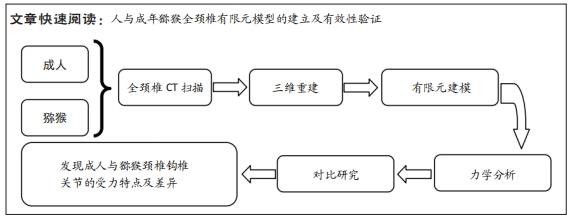
文题释义:
猕猴颈椎:与人类颈椎具有高度的相似性,无论是从脊柱解剖结构(7块颈椎),还是运动生理功能等方面与人类非常接近,尤其是均具备颈椎所特有的结构——钩椎关节,因此,拟通过对二者间颈椎的有限元分析以比较力学差异,为人工颈椎椎体置换、手术治疗等方面提供理论依据。
背景:猕猴颈椎与人类颈椎具有高度相似性,无论颈椎数量还是椎骨解剖结构,尤其是均具有颈椎所特有结构——钩椎关节,因此可以作为理想的动物实验模型,但关于二者间的力学对比研究则鲜有报道。
目的:建立成人颈椎与成年猕猴颈椎的有限元模型,围绕钩椎关节的受力特点利用有限元分析手段比较二者间在6种工况下的应力与位移变化特点,为临床椎体置换等提供理论依据。
方法:选取1例40岁成人志愿者和1只7岁龄的成年雄性猕猴,分别进行螺旋CT薄层扫描,将原始颈椎CT数据导入Mimics 21.0中初步建立三维模型,通过颈椎各节段、椎间盘、韧带等模型优化、赋值、装配组织网格,最后利用Abaqus构建颈椎有限元模型,分别对模型加载75 N附加载荷和1 N·m外力偶矩,在前屈、后伸、左右侧屈和左右旋转6种工况下进行力学对比分析,以发现二者间的力学变化趋势和差异。
结果与结论:①人和猕猴颈椎均具备颈椎特有的结构——钩椎关节,通过有限元建模比较发现二者间钩椎关节应力变化和位移变化走势基本一致,应力和位移集中点均在C5处,人和猕猴间比较差异有显著性意义;②但猕猴仍可作为临床颈椎动物模型的最佳备选动物,为临床人工颈椎椎体置换等方面提供理论依据。
https://orcid.org/0000-0003-0059-4921 (王星)
中国组织工程研究杂志出版内容重点:人工关节;骨植入物;脊柱;骨折;内固定;数字化骨科;组织工程
中图分类号:
